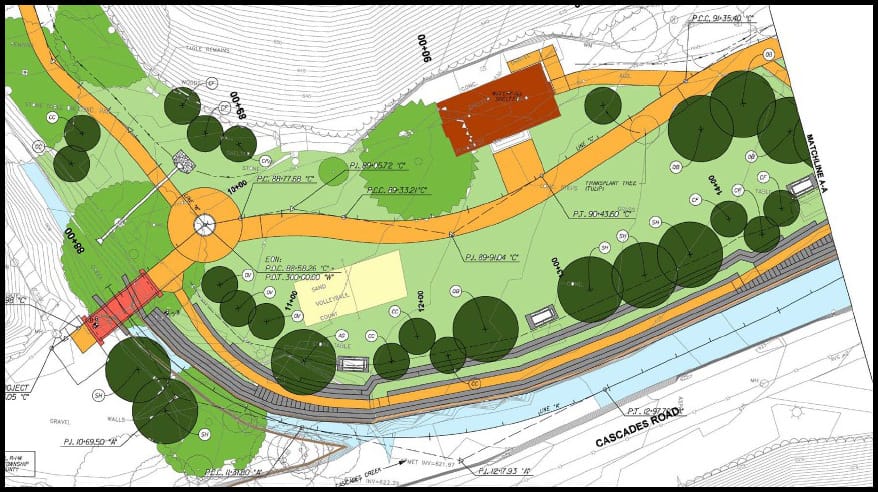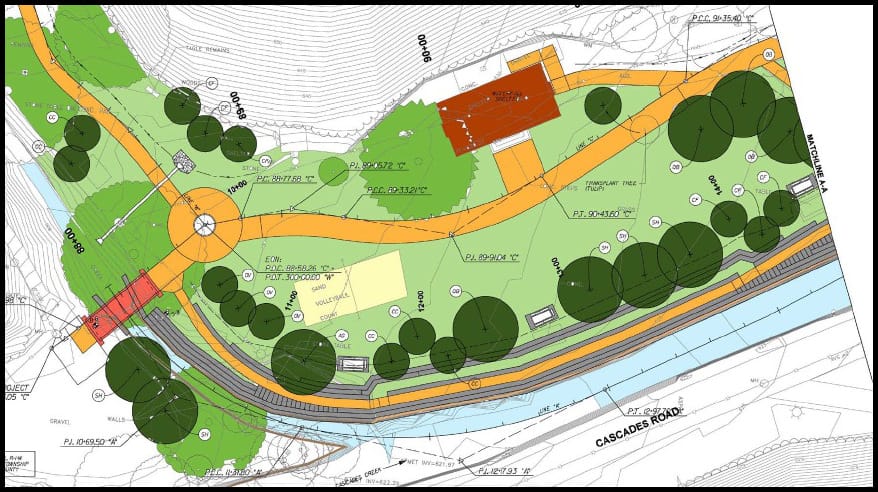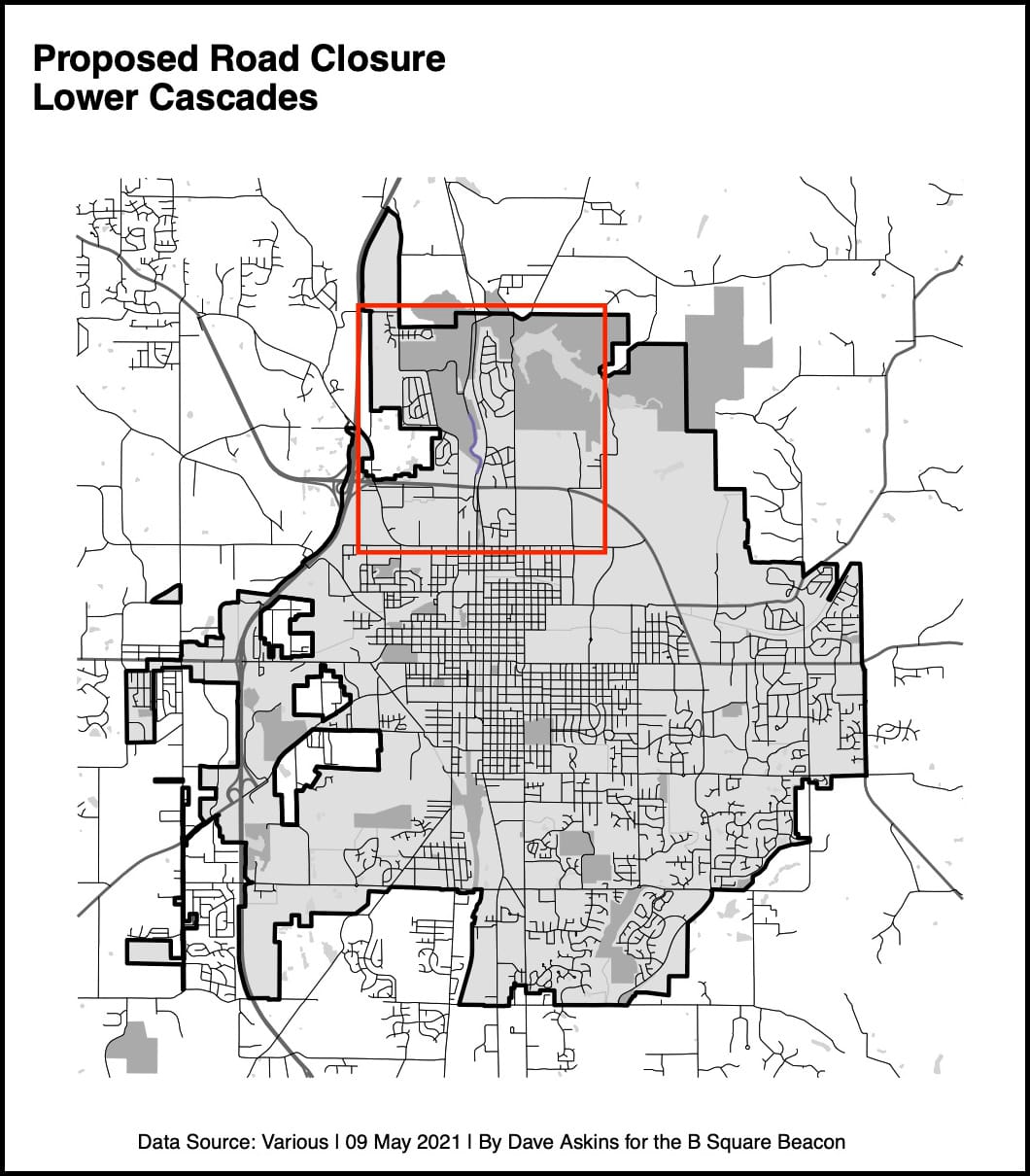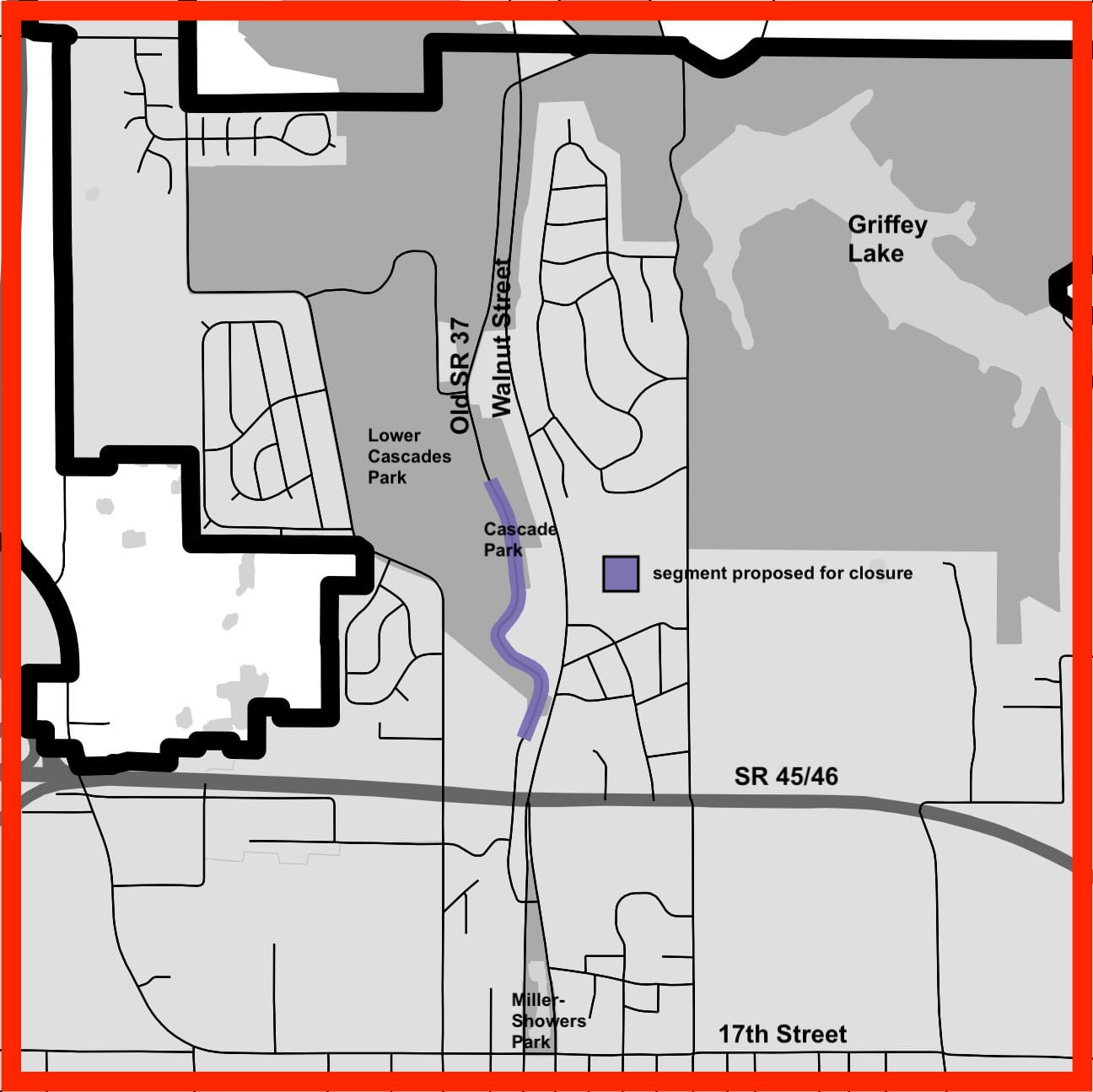$1.8 million OK’d for Lower Cascade paths, with road closure decision on horizon




At its regular Monday meeting, Bloomington’s redevelopment commission approved a $1.8-million contract with Scenic Construction Services, Inc. for work in Lower Cascades Park on the city’s north side.
The project calls for construction of a quarter mile of paved trail from the Sycamore Shelter on the north end of the park to the waterfall parking lot, a new ADA-accessible boardwalk up to the waterfall, and stabilization of 430 feet of streambank.
The work is expected to start in early July, according to Bloomington parks operations director Tim Street. Street filled the position when Dave Williams retired.
Street told The Square Beacon that the hoped-for timing is after the Fourth of July weekend.
The project is being funded from a mix of tax increment finance (TIF) revenue, “bicentennial” bonds, and 2016 parks general obligation bonds, according to the RDC resolution approved on Monday.
The current pilot closure of the road through Lower Cascades Park is related geographically to the trail construction and streambank stabilization. On June 22, the three-member board of public works is expected to take a vote on a permanent road closure.
According to the city, the conversion of the road to a route just for bicycles and pedestrians is intended to: “expand and integrate with Bloomington’s network of walking and biking trails; provide a safe, accessible destination for recreation and exercise; and to offer bicycle commuters additional options for safer routes.”
Accessibility issues related to the possible road closure also got some discussion from RDC members on Monday.
The road closure affects the distance someone would have to cover without a motor vehicle to reach the Waterfall Shelter from the nearest parking spot.
Project financing
About the funding source, city controller Jeff Underwood clarified that the $300,000 worth of TIF revenue the RDC was approving that day stemmed from the Kinser Pike/Prow Road TIF district, which is still its own separate TIF district, not a part of the city’s consolidated TIF district.
The reason the parks department approached the RDC for the $300,000 worth of TIF funds, Street said on Monday, was the over-budget bid submission. The parks department had identified $1.5 million in “bicentennial” bonds and parks general obligation bonds, which left it $300,000 short.
Street said, “We had value-engineered this project to the point where we thought feasible, and still wanted to continue.” Street added, “So the $300,000 would certainly help us make sure the project does go in a timely fashion.”
Street characterized the bid market right now as “wildly unpredictable.” Bids on other recent city projects have also come in high, Street said. About the potential cost of delay, Street said the $500,000 in “bicentennial” bonds was time sensitive, and the city risked losing out on the chance to use that money.
The scope of work for the streambank stabilization was reduced by a couple of bid alternates, from over 1,000 feet to the 430 feet in the contract.
In an email to The Square Beacon, Street said, the streambank stabilization to be started this summer would focus on the eroded section of wall on the western side of the creek between the gravel parking lot near the waterfall and the pedestrian bridge between the playground and waterfall shelter.
Road closure: Accessibility
At Monday’s meeting, RDC members Deborah Myerson and Deborah Hutton raised questions about accessibility to the Waterfall Shelter.
Measured out on Google Earth, getting from the parking lot at the Sycamore Shelter, at the north end of the park, to the Waterfall shelter, would mean covering about 950 feet of a new, paved multi-use path, on foot or using a wheelchair, once the project is complete. From the Waterfall Shelter, it would be another couple hundred feet to the base of the new boardwalk, and 700 more feet of boardwalk up to the waterfall.
To get from the gravel parking lot at the foot of the waterfall trail to the Waterfall Shelter would mean about 250 feet to cover. That’s the gravel patch currently approachable from the road, using the stream’s at-grade concrete ford. If the road is closed, that is not an option.
Asked by Hutton to describe the distances involved, Street pegged it at a little under a quarter mile from the Sycamore Shelter to get past the Waterfall Shelter to the base of the boardwalk, and then 700 feet of boardwalk up to the waterfall.
Hutton responded: “Wow, that seems completely impossible for lots of people—way too far.” She added, “ I can’t imagine someone with a walker, or a prosthetic set of legs, or pushing a wheelchair, in their own wheelchair, to do all that distance.”
Street noted that the boardwalk surface up to the waterfall will reflect a “vast improvement” in the surface of the trail, which he described as “rugged—dirt, lots of tree roots, things like that.”
Myerson asked Street if the parks department had talked with the city’s council for community accessibility (CCA) about the project. Street told Myerson that parks staff have talked with Michael Shermis, the city’s staff liaison to the CCA. The boardwalk will meet ADA requirements for rise-over-run, resting platforms, and other elements, Street said.
The current trail from the parking lot does not go all the way to the Waterfall Shelter before turning into grass, Street told the RDC. The pavement of the whole distance will also be an improvement for the surface, Street said.
The decision on a permanent closure to the road through Lower Cascades appears to be on course to be made on June 22 at a meeting of the three-member board of public works.
Why doesn’t the city council make the decision on closing the road permanently? The administration is relying on the state law that gives a board of public works the authority to supervise all streets and alleys:
IC 36-9-6-2 Supervision of streets, alleys, and city property
Sec. 2. Unless otherwise provided by statute or ordinance, the works board shall supervise the streets, alleys, sewers, public grounds, and other property of the city, and shall keep them in repair and good condition. The works board shall provide for the cleaning of city streets and alleys.
Under Bloomington’s local law (an ordinance), experimental road closures can be authorized by the chief of police or the traffic engineer, but must be considered by the city council in order to be made permanent:
15.08.040 – Temporary, experimental or emergency traffic regulations.
The chief of police with the approval of the transportation and traffic engineer is empowered to make regulations necessary to effectuate the provisions of this title and any other city traffic ordinances, and to make and enforce temporary or experimental regulations. Either the chief of police or the transportation and traffic engineer is empowered to make regulations necessary to deal with emergencies or special conditions.(a) Temporary, experimental, or emergency regulations shall not remain in effect for more than one hundred eighty days;
(b) In the event the chief of police, transportation and traffic engineer or traffic commission recommends that any order entered under this section be made permanent, such recommendation shall be made in writing and submitted to the common council for its consideration within one hundred twenty days of the date of entry of said order.
Does that piece of local law satisfy the “unless” clause in the state statute, and effectively take the authority for street closures from the board of public works, appointed by the executive branch, and assign it to the legislative branch?
Asked about that issue, city council attorney Stephen Lucas said in an email message to The Square Beacon: “I wouldn’t tell the council it could rely on BMC 15.08.040 as affecting the authority of the board of public works to act with regard to Lower Cascades.”




Comments ()